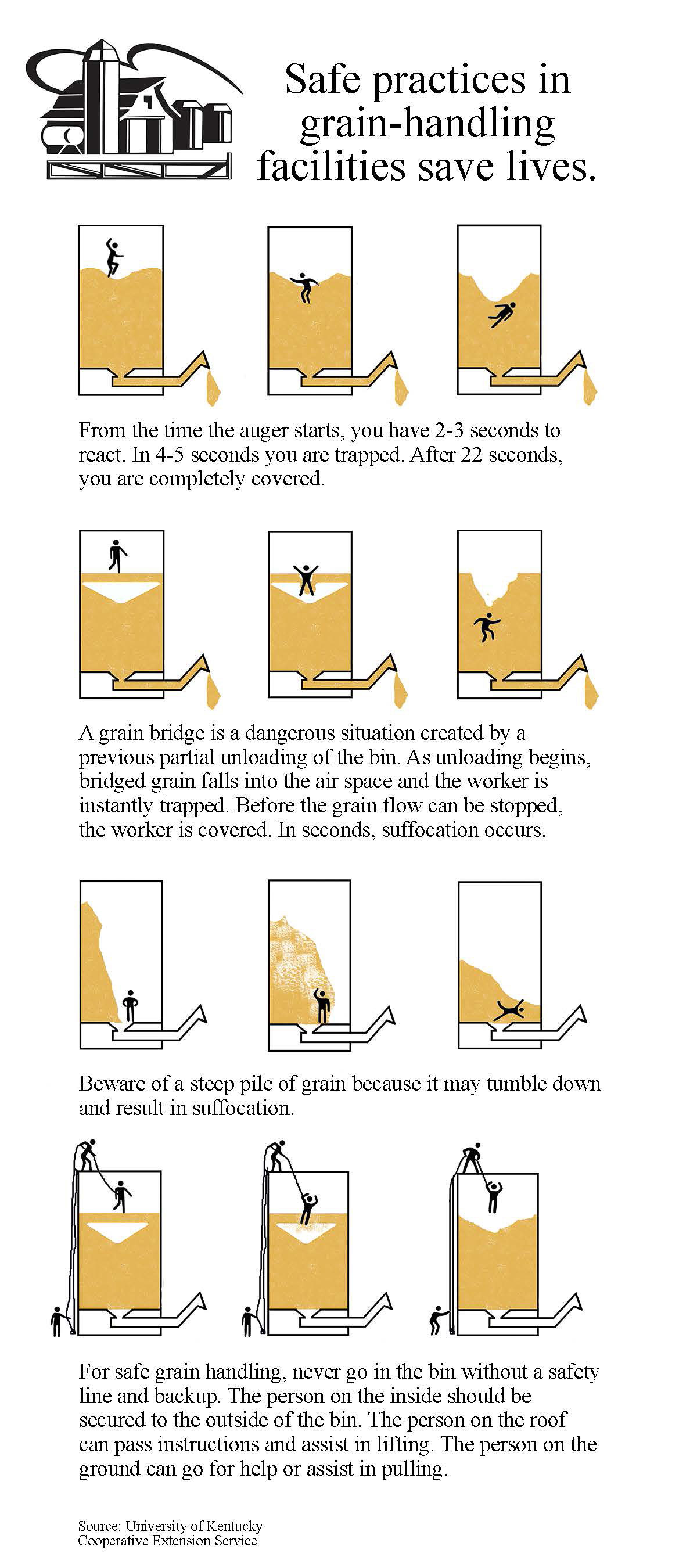Worker entry into grain storage bins
 Worker entry into grain storage bins
Worker entry into grain storage bins
Engulfment and suffocation hazards
Grain storage bin entry is very dangerous and exposes workers to serious suffocation hazards, which is a leading cause of fatalities in this industry. Suffocation can occur when workers are engulfed by grain or when bins develop hazardous atmospheres or a lack of oxygen.

Engulfment can occur when a worker does the following:
- Stands on moving/flowing grain (Figure 1). The moving grain acts like quicksand and buries the worker in seconds.
- Stands on or below a “bridging” condition (Figure 2). Bridging occurs when grain clumps together because of moisture or mold, creating an empty space beneath the grain as it is unloaded. If a worker stands on or below the bridged grain, it can collapse, burying the worker.
- Stands next to an accumulated pile of grain on the side of the bin (Figure 3). The grain pile can collapse onto the worker unexpectedly or when the worker attempts to dislodge it.
The grain’s behavior and weight make it extremely difficult for a worker to get out of the grain without assistance. Tragically, incidents in grain bins often result in multiple fatalities because coworkers attempt rescue and fall victim as well. These fatalities are preventable if employers follow work practices and provide training and equipment as required by OSHA’s Inspection of Grain Handling Facilities standard, 29 CFR 1910.272.
Where workers enter storage bins, employers must:
- Turn off and disconnect, lockout/tagout, or block off all mechanical, electrical, hydraulic, and pneumatic equipment that presents a danger, particularly grain-moving equipment. Grain must not be emptied or moved into or out of the bin while workers are inside because it creates a suction that can pull the worker into the grain in seconds.
- Prohibit walking down grain and similar practices where a worker walks on grain to make it flow.
- Prohibit entry onto or below a bridging condition, or where grain is built up on the side of the bin.
- Provide each worker with a body harness with a lifeline or a boatswain’s chair if they entering a bin from a level at or above stored grain, or when a worker will walk or stand on stored grain. Ensure that the lifeline is long enough to prevent a worker from sinking further than waist-deep in grain.
- Provide workers with rescue equipment, such as winch systems that are specifically suited for rescue from the bin (Figure 4).
- Station an observer who is equipped to provide assistance and perform rescue operations outside the bin (Figure 4).
- Ensure that communications (visual, voice, or signal line) are maintained between the observer and the workers who entered the bin.
- Test the air within a bin for oxygen content and the presence of hazardous gases before entry.
- Provide and continue ventilation until any unsafe atmospheric conditions are eliminated.
- If toxicity or oxygen deficiency cannot be eliminated, workers must wear appropriate respirators.
- Issue a permit each time a worker enters a bin unless the employer is present during the entire entry operation. The permit must certify that the above precautions have been implemented before workers enter the bin.
© University of Kentucky Cooperative Extension Service. Images reproduced with permission.
Additional Guidance
For additional information on safe work practices in grain handling facilities, please see:
This bulletin has been prepared as an underwriting reference for members of Grinnell Mutual Reinsurance Company and does not signify approval or disapproval by the Company of any product or device. Please do not copy or reproduce any portion of this bulletin without the written permission of Grinnell Mutual Reinsurance Company. The information included in this publication and program was obtained from sources believed to be reliable, however Grinnell Mutual makes no guarantee of results and assumes no liability in connection with its use. It is the user’s responsibility to comply with any applicable regulations or laws. Information obtained from or via Grinnell Mutual should not be used as the basis for legal advice, but should be confirmed with alternative sources.